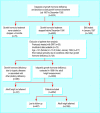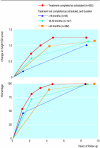Adult height after long term treatment with recombinant growth hormone for idiopathic isolated growth hormone deficiency: observational follow up study of the French population based registry
- PMID: 12114235
- PMCID: PMC117125
- DOI: 10.1136/bmj.325.7355.70
Adult height after long term treatment with recombinant growth hormone for idiopathic isolated growth hormone deficiency: observational follow up study of the French population based registry
Abstract
Objective: To evaluate the efficacy of recombinant growth hormone for increasing adult height in children treated for idiopathic isolated growth hormone deficiency.
Design: Observational follow up study.
Setting: Population based registry.
Participants: All 2852 French children diagnosed as having isolated idiopathic growth hormone deficiency whose treatment started between 1987 and 1992 and ended before 1996.
Main outcome measures: Change in height between the start of treatment and adulthood; classification of patients according to whether treatment was completed as scheduled or stopped early.
Results: Adult height was obtained for 2165 (76%) patients. The mean dose of growth hormone at start of treatment was 0.42 IU/kg/week. Height gain was 1.1 (SD 0.9) standard deviation (SD) scores, resulting in an adult height of -1.6 (0.9) SD score (girls, 154 (5) cm; boys, 167 (6) cm). Patients who completed the treatment gained 1.0 (0.7) SD score of height in 3.6 (1.4) years. Patients with treatments stopped early gained 0.6 (0.6) SD score in 2.7 (1.4) years while receiving treatment and a further 0.4 (0.9) SD score after the end of treatment. Most of the variation in height gain was explained by regression towards the mean, patients' characteristics, and delay in starting puberty. Severe growth hormone deficiency was associated with better outcome. Each year of treatment was associated with a gain of 0.2 SD score(1.3 cm).
Conclusion: The effect of growth hormone is unclear in many patients treated for so called idiopathic isolated growth hormone deficiency. Most of the patients have pubertal delay and a spontaneous growth potential, which must be taken into account when measuring the effect and cost effectiveness of treatments. Growth hormone deficiency should be clearly distinguished from pubertal delay, and criteria should restrict the definition to patients with severely and permanently altered growth hormone secretion as our results support the use of growth hormone in such patients. Long term trials are required for most patients currently treated.
Figures



Comment in
-
Growth hormone in growth hormone deficiency.BMJ. 2002 Jul 13;325(7355):58-9. doi: 10.1136/bmj.325.7355.58. BMJ. 2002. PMID: 12114222 Free PMC article. No abstract available.
-
Growth hormone in growth hormone deficiency. Deficiency cannot be diagnosed solely on the results of stimulation tests.BMJ. 2002 Nov 2;325(7371):1037. BMJ. 2002. PMID: 12420334 No abstract available.
References
-
- Guyda HJ. Commentary. Four decades of growth hormone therapy for short children: what have we achieved? J Clin Endocrinol Metab. 1999;84:4307–4316. - PubMed
-
- The drug and therapeutic committee of the Lawson Wilkins Pediatric Endocrine Society. Guidelines for the use of growth hormone in children with short stature. J Pediatr. 1995;127:857–867. - PubMed
-
- Vance ML, Mauras N. Drug therapy: growth hormone therapy in adults and children. N Engl J Med. 1999;341:1206–1216. - PubMed
-
- Cole T. Methodology for the analysis of longitudinal height data during puberty. KIGS Report. 1993;10:37–44.
Publication types
MeSH terms
Substances
LinkOut - more resources
Full Text Sources
Medical
